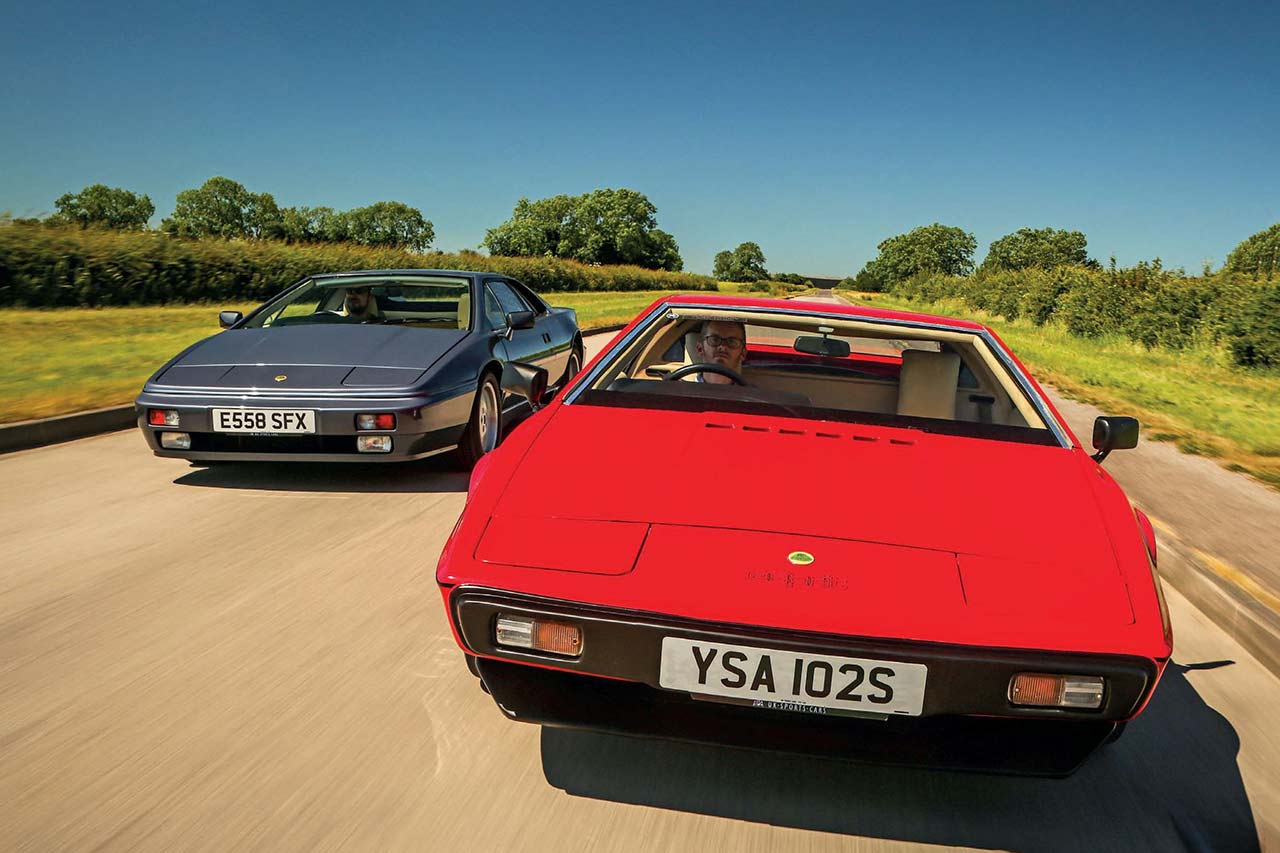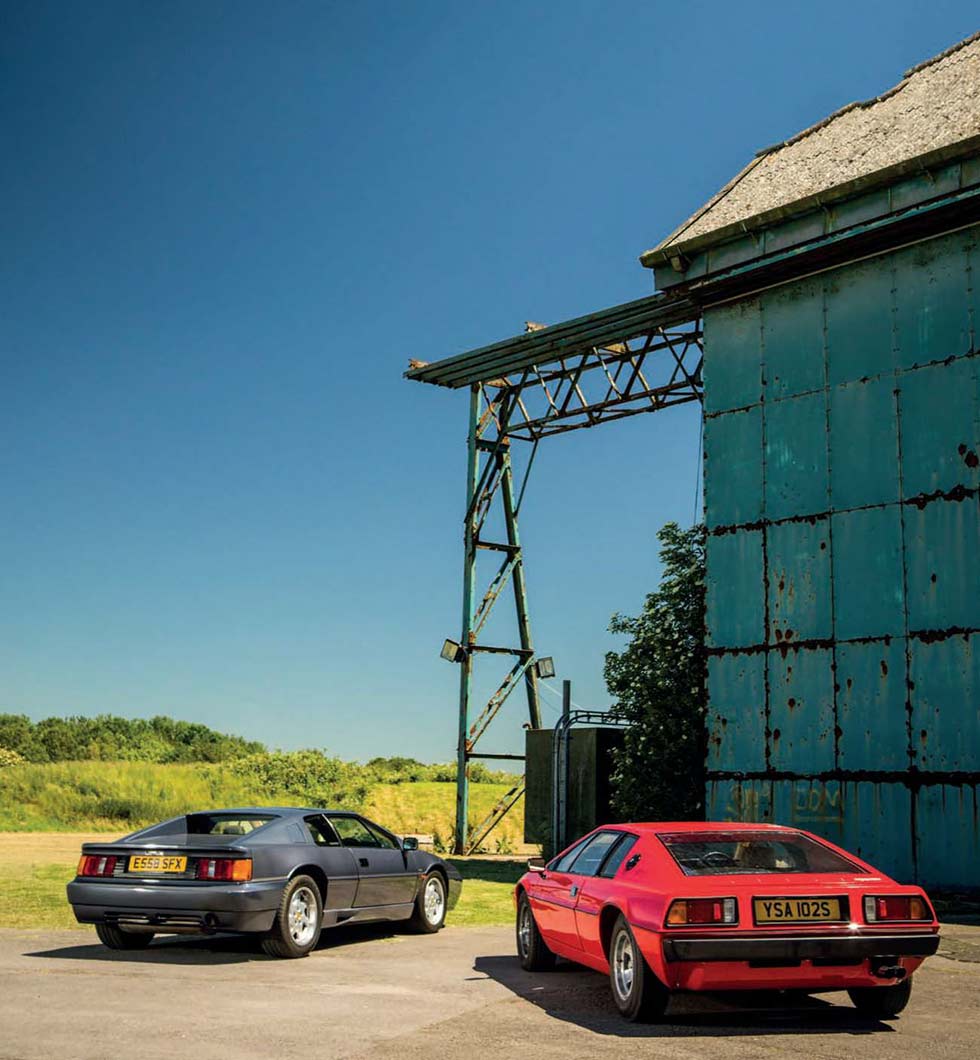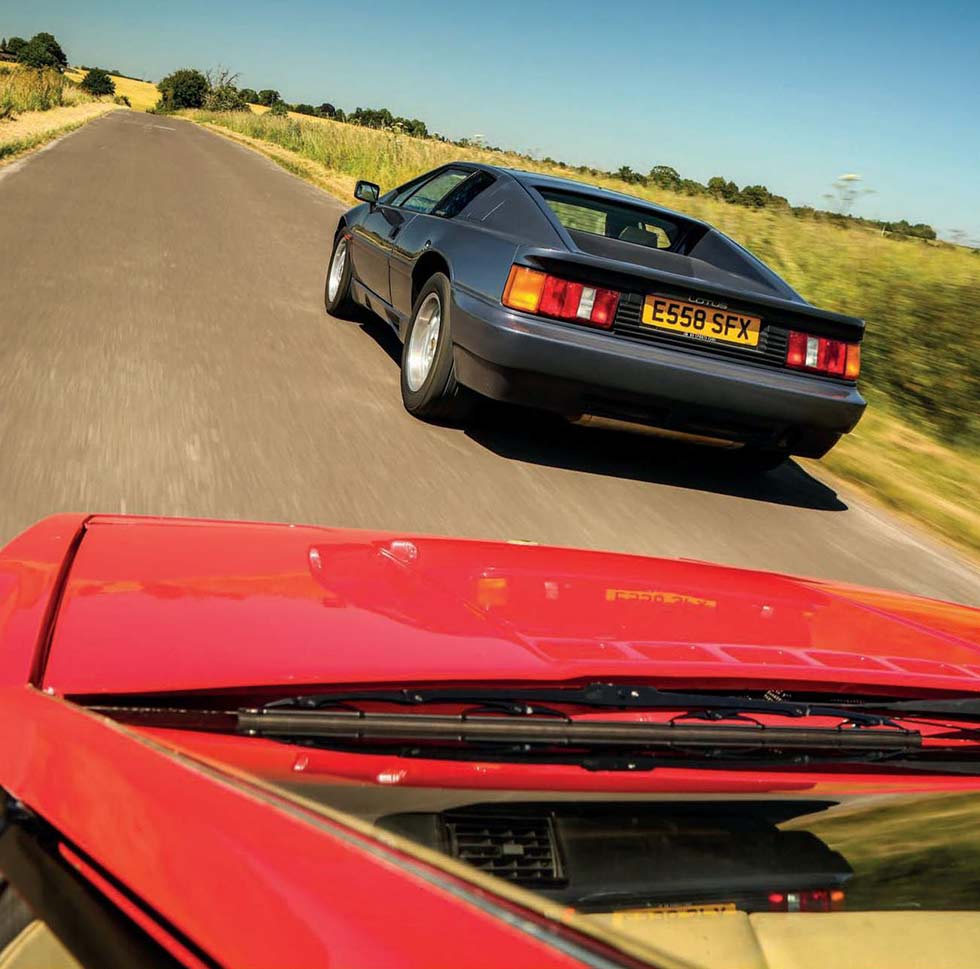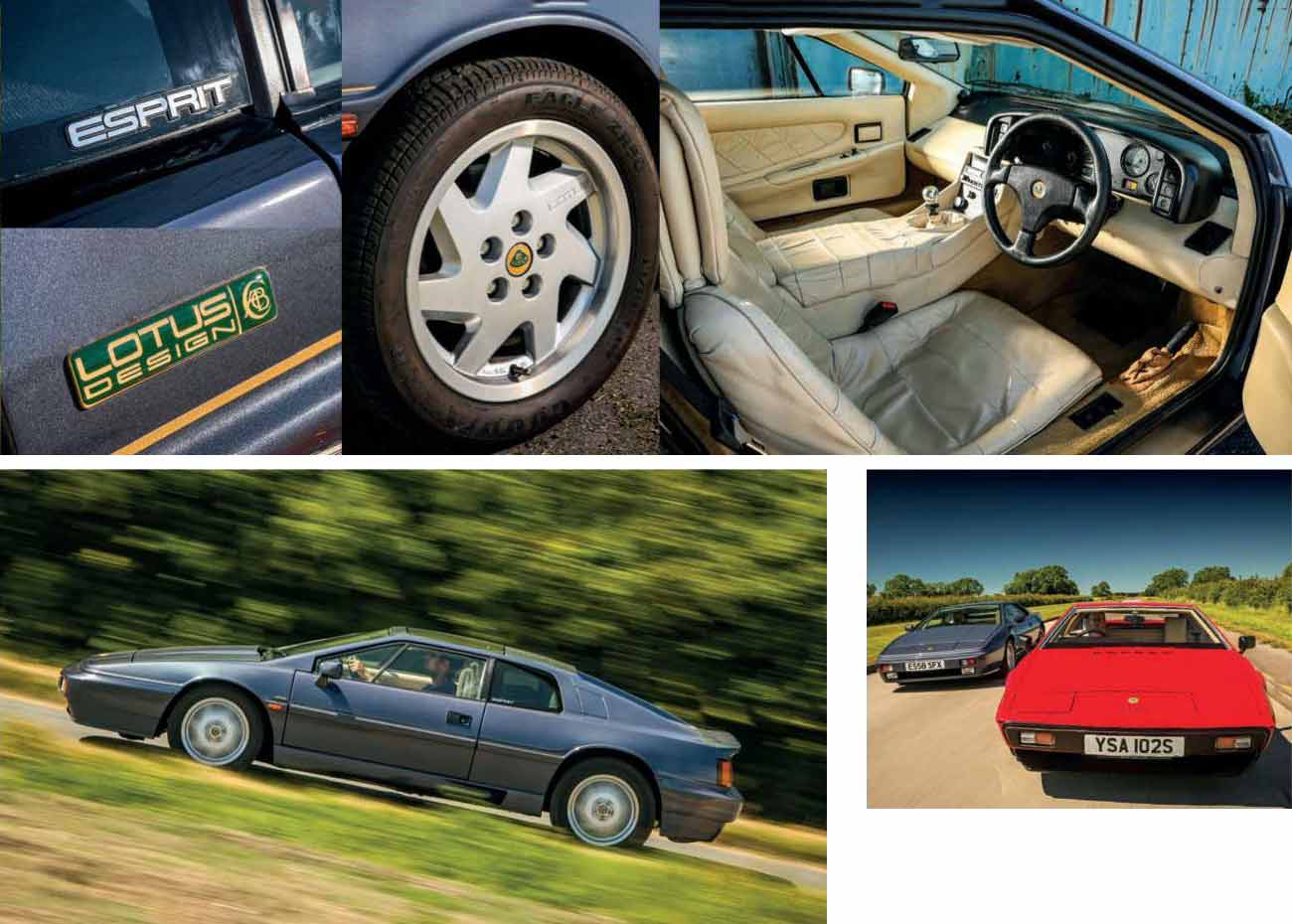
Lotus biggest bargain Esprit trough the ages. Hethel’s junior supercar Giugiaro Esprit takes on Peter Stevens’ facelifted ‘80s incarnation. Bargains both, but which generation of Lotus is best? Ross Alkureishi experiences angular creases and soft curves, as he chooses between Giugiaro and Stevens variants of Lotus’ enduring mid-engined Esprit. Photography Tony Baker.
Cutting wedge design
Growing up in the 1970s, I can distinctly remember a Corgi James Bond Lotus Esprit being one of my most prized possessions. Yet even so, I’ve never really been much of a wedge man. This mystifying discord is accentuated today by the striking image of a Calypso Red S1 in my mirrors: it’s simply mesmerising. Those sleek Giorgetto Giugiaro lines are a lesson in design simplicity, and endow the low-slung Esprit with supercar dynamism. Despite the fact that I’m behind the wheel of a more powerful, facelifted example, it’s an intimidating presence.

As both cars arrow through Wiltshire’s towns and villages, drivers and pedestrians give double- takes, turning from the origami angles of the S1 to my softer, more-rounded Esprit. Each completes their own assessment, pitting one Lotus against the other before settling their gaze on their respective choice. Thumbs-up are elicited at a fair rate, the older sibling just edging it. Perhaps it’s the colour – a red sports car on a beautiful summer’s day is always a winner.
Of course, it could just be that the pure lines of the original still hold the same power to bewitch as Giugiaro’s ‘Silver Car’ design study. Commissioned after the 1971 Geneva Salon, when he suggested to Lotus founder Colin Chapman that they should collaborate, the designer was given the task of crafting a prototype for the successor to the mid-engined Europa. Nine months later, the car appeared on the Italdesign stand in Turin, where its futuristic outline beguiled the crowds.
After a convoluted gestation period, prototype number two arrived in November ’1973. This time a joint creation, it ditched the concept’s bastardised Europa chassis in favour of a pre- production version of the finished car’s backbone design. The intervening fuel crisis had, however, caused a significant shift in Lotus’ plans. The intention had been to offer four-cylinder and V8 variants, but that was no more; the new car would be available only with the 16-valve, double-overhead-camshaft ‘four’ that in 1974 would power its front-engined Elite sibling.
Lotus had a rich history of modifying other manufacturer’s powerplants, but the 907-series unit was its first fully developed engine. The firm had intended to utilise a 2-litre Vauxhall slant-four block but experience with it in the 62 racer had exposed weaknesses. As a result, Ron Burr simply used it as the basis for the new homegrown motor. The final piece of the Esprit jigsaw was a Citroen SM five-speed transaxle, which – despite that model already being defunct – was built with Lotus-selected ratios and, most importantly, at an affordable price.

The press greeted the model enthusiastically at its October 1975 Paris motor show unveiling. Motor Sport called the Esprit Colin Chapman’s ‘trump card’, citing a list price of £5814, a top speed of 138mph and a 0-60mph sprint of 6.8 seconds. There was, though, a small caveat, the magazine stating that the figures were ‘excellent for a 2-litre, four-cylinder production sports car, so long as they are more accurate than those quoted by Lotus for the Elite at its introduction’.
The trouble was, they weren’t. It quickly became apparent that there was a distinct lack of go, for all that snazzy space-age show. Autocar managed 0-60mph in a disappointing 8.4 secs and a top speed of just 124mph. Supercar looks but without the rocket-propelled oomph to back
them up could be forgiven at a bargain list price, but that had swollen to £7883 by 1976-whenan Alfa Montreal, which was quicker, cost £6999 – and it was heading even further north. It would take the 1980 arrival of the Turbo – first in limited-edition Essex liver)’, and then standard Turbo Esprit guise – to finally promote the performance into genuine supercar territory. Plus a significant improvement in build quality for it finally to be deemed a true contender.
Yet you can excuse Geoff Mitchell’s S1 its period limitations as you devour its alluring exterior. That form isn’t just for show, either, the shape returning an impressive aerodynamic Cd of 0.34 – remember that figure, though. Its glassfibre upper and lower halves are bonded together, producing a black seam that draws the eye and accentuates the pin-sharp joining crease.
‘THE RESULTING SOFTER PROFILE BROUGHTTHE MODEL SEAMLESSLY INTO THE NEW DECADE’
Inside it’s just as delicious, even if there’s no Bond girl to keep me company. You sit very low, with the reclined bucket seat offering plenty of support. Prominent funky green Veglia dials stare out of a wraparound console, with the gear-stick and steering wheel – a later addition, rather than the original two-spoke item – perfectly positioned. There’s a mild regret that it’s finished in champagne-coloured leather, rather than the Donald Where’s Your Troosers? tartan of many S1s, yet it retains a special feeling.

The engine fires with a gruff bark from the twin Dell’Orto carburettors, but it’s more Lotus Cortina than supercar. The Esprit’s inherent drama screams out for a yowling V6 or torque-laden V8, and it’s easy to get a sense of how underwhelming it could have felt to some when new. The twin-cam – relatively sorted when it hit the Esprit after initial difficulties in the Jensen Healey-is willing and eager; it’s not as free spin-ning as an Italian four-pot but 160bhp is decidedly healthy, and propels it along quite nicely. The trouble is, that description in itself is indicative of the period quandary.
The gearbox surprises, with shifts being much more positive than expected from an indirect rod and cable arrangement. At low speed, the wide track means that the steering doubles as an upper-body toning device, but it has that trademark Lotus feel and, once up to speed, it’s a revelation. Within two or three corners your confidence in the car’s grip has you dabbing the brakes late, before tucking in that pointy snout and powering through. It’ll understeer on the limit, but even at nine-tenths you’re devouring apexes faster than you might attempt in other contemporary machinery.
After a slow start, sales of the S1 began to build until the lightly modified 1978 S2 arrived, with improved cooling – thanks to distinctive ‘ears’ behind the rear quarter windows – and better crosswind stability from a redesigned front spoiler. The S2.2 brought a capacity increase to 2174cc, which resulted in the same power output but a significant shift in torque – up to 160lb ft – and, for the first time, a galvanised chassis. In ’1981, the normally aspirated S3 adopted the stronger and more durable Essex Turbo chassis, with its new top-link suspension arrangement resulting in improved comfort and handling.
This model, alongside the production Turbo Esprit, would form the bedrock of the company’s sales for the next six years, seeing it through the trauma of Chapman’s death plus various changes of ownership. Continually improved, the later iterations were in a different league when it came to build quality. Yet more than a decade after going on sale, and despite performance never having been stronger, the Esprit was losing its edge. Or rather, it needed to lose them. Tastes had moved on, and its Etch A Sketch lines remained firmly rooted in a ’70s miasma of medallion men, economic strife and funk)’ disco grooves.
“It was obvious the Esprit was looking dated, and sales were falling away,” remembers the firm’s then-chief designer (styling), Peter Stevens. “A new car was needed but, as ever with Lotus, there was little money so there’d be no major changes to the chassis. I thought the first show car that Giugiaro did was great. It was quite simple, with no silly adornment, but by the time it got back to Lotus it had lots of stuff on it – upturned spoilers, it was a bit fussy. With the new one, it was a chance to simplify it a bit to what was the original intention.”
Codenamed X-180, it utilised a new Vacuum Assisted Resin Injection (VARI) process that was both quicker and resulted in better-quality panels. Stevens’ use of epoxide structural adhesives on the overlapping joint between the upper and lower body halves also allowed him to hide “one of the things I hated about the original”.
‘THE GRUFF BARK FROM THE CARBURETTORS IS MORE LOTUS CORTINA THAN SUPERCAR’
That resulting shape, with its softer profile, finally brought the model seamlessly into the 1980s: “Initially, we were very restricted in terms of what we could do with the body. It was supposed to have the same perfectly flat windscreen but I persuaded Mike Kimberley that a little curvature would go a long way. I also took the original to a wind tunnel and found it had a Cd of 0.44. The aerodynamic drag had been decided by the marketing people, rather than engineering. My challenge was to get close to their claim; we got to 0.33, and the marketing people said: ‘That doesn’t sound any different’.”
The only thing left to do was find out how the redesign would be received: “I was terribly aware that the original was such a spectacular thing, and there was me – a comparatively young lad. I didn’t think I could do better but that I could do something different that was still recognisable as an Esprit.”
The facelifted car made its debut at the 1987 London Motorfair. “I saw Giugiaro approaching the stand and I did think ‘oh my goodness, here’s the great man’,” remembers Stevens. “But it was just magic, he put his arm round my shoulder and said: ‘You’ve done a fantastic job with the car’.” The public thought so, too, with sales of 1058 Esprits in ’1988, compared to just 454 in ’1986.
Adrian Briscoe’s normally aspirated example looks more elongated and planted than the earlier car, thanks principally to the adoption of buttresses at the rear. In reality, Stevens and his team had to ensure that every major dimension remained within a 1 in growth boundary, so that impression is just a trick of the eye. The body-coloured bumpers are preferable to the earlier black items, and lend it a more cohesive feeling, with a hint of Lamborghini Diablo to the front. No doubt to Stevens’ chagrin, it also sports a later SE rear spoiler. Does it convey the same sense of drama as the Si? The answer has to be no, but that’s simply down to the original car’s impact.

Despite no plans for a new interior, Stevens found that no one at Hethel knew how much the then-current design cost to fit. After researching it, he found that he was able to produce a new version both fester and cheaper. There’s more headroom, plus seats that have increased back-rest rake angles. The instrumentation consists of six small VDO dials but they’re quite difficult to read due to their size, and decidedly more sober. Despite a slightly bigger footwell, the pedals feel closer together, and you find yourself retracting your right leg slightly to dance Nureyev-style on the throttle and brake to prevent fouling.
On the road, it’s instantly familiar but comprehensively superior. While the first-generation car still has aspects that feel almost kit-car in their origins, this is a sophisticate. At speed there’s none of the encroaching wind noise or resonance that blighted the S1; instead the cabin remains serene, save for the intake noise behind you. Thanks to the new Renault 25 transaxle, the gearshift is meatier, requiring a firm hand – particularly when engaging second and fifth, because the lever has a tendency to centre.
The increased torque of the 2.2-litre engine, combined with a 25% improvement in the aero-dynamics, means that performance is much stronger – a full two seconds being knocked off the 0-60mph time. Yet it’s the earlier suspension changes and further increase in tyre rubber that make this Lotus such a pleasure to handle; it transforms something as mundane as a roundabout into one of life’s little pleasures.

The Si is a bit undercooked, more likely to suffer mechanical histrionics and the cabin can be a bit coarse at speed, but its wild purity of line still has the capacity to shock. Objectively, though, it’s the Stevens car all the way. It’s superior in almost every sense, but particularly in terms of performance – the major criticism levelled at the Si. It also paved the way for an incredible further 17 years of production, including a second restyle, plus, finally, in 1996, as had been the intention at the outset, a V8.
And yet the little boy inside – and a certain Mr Bond – always wins out. Would I ever tire of seeing the Si’s piercing reflection in a shop window as I darted past? I doubt it. Then there’s the memory of that Corgi toy and, later, of Roger Moore gunning his white Esprit away from a helicopter, before plunging into the sea where it turns into a submarine… I take it back, I’ve always been a wedge man.
Thanks to Geoff Mitchell; Adrian Briscoe; Paul and Sam Clugston at UK Sports Cars: 01227 728190, www.uksportscors.com; Swindon Karting Arena:
The inside line
“Always look at an Esprit’s interior first,” says UK Sports Cars’ Paul Clugston “If it’s really scruffy then walk away, because this is usually indicative of a lack of care and the way the car has been driven. Check the chassis on pre-S2.2 examples because they were non-galvanised. Look for a good service history and a cambelt replacement within the past three years or 24,000 miles. Also inspect for a cracked manifold because that is an engine- out job: you can hear the ‘tick-tick’ of the exhaust note if the gaskets are leaking or the manifold is damaged.”
Early unrestored Sis will need constant attention and, according to Clugston, it’s important to keep on top of any issues. An S2 will require slightly less maintenance, and S3s onwards – especially post-1985, when build quality improved – are less troublesome.
A good example will need about £500 per year on servicing, plus general odds and ends – most parts are available and servicing costs very reasonable. An early Stevens car – especially the rare normally aspirated version with the superb HC engine – will cost roughly the same and give many years of trouble-free performance. Turbo cars need more attention, so allow £1000. On all models, the cambelt needs replacing every three years and that’s c£400, which includes the belt and tensioner.
As Clugston explains: “Originality is important, so look out for different alloys and V8 spoilers on earlier cars: Sis are highly prized, especially if they are white with the original tartan interior – you’d pay £25,000-plus for a good example. Essex Turbos are the Holy Grail of Giugiaro cars because fewer than 30 exist, but it’s the Stevens models that are quite undervalued, with a really nice Turbo or N/A around the £15,000 mark.”
Tech and photos
TECHNICAL DATA FILE SPECIFICATIONS LOTUS ESPRIT S1
Sold/number built 1976-1978/718
Construction steel backbone chassis, glassfibre body
Engine mid-mounted, all-alloy, 16-valve, dohc 1973cc ‘four’ with two twin-choke Dell’Orto 45 DHLA carburettors
Max power 160bhp @ 6200rpm / DIN nett
Max torque 140lb ft @ 4900rpm / DIN nett
Transmission five-speed manual, driving rear wheels
Suspension independent, at front by unequal- length wishbones, anti-roll bar rear diagonal trailing arms and lateral link with fixed-length driveshafts; coil springs, telescopies f/r
Steering rack and pinion
Brakes discs all round, inboard at rear
Length 13ft 9 in (4191mm)
Width 6ft 1 ½ in (1867mm)
Height 3ft 7 ¾ in (1111mm)
Wheelbase 8ft (2438mm)
Weight 1980lb (898kg)
0-60mph 8.4 secs
Top speed 124mph
Mpg26
Price new £7883 (1976 UK)
Price now from £20,000 (2018 UK)

TECHNICAL DATA FILE SPECIFICATIONS LOTUS ESPRIT SE (where different)
Sold/number built 1987-‘1989/268
Engine 2174cc
Max power 172bhp @ 6500rpm / DIN nett
Max torque 160lb ft @ 5000rpm / DIN nett
Suspension, front: upper wishbones, lower transverse links, anti-roll bar rear unequal-length double transverse links, radius arms
Weight 3434lb (1559kg)
0-60mph 6.5 secs
Top speed 138mph
Mpg 26 (est)
Price new £22,950 (1987 UK)
Price now from £15,000 (2018 UK)






